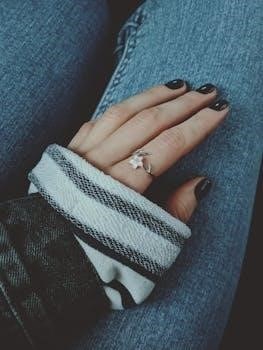
Finding the correct ring size is crucial for comfort and security. Rings that fit poorly can slip off or cause discomfort. Understanding how to accurately measure your finger is essential before purchasing any ring‚ ensuring a perfect fit every time.
Importance of Accurate Ring Size
Accurate ring sizing is paramount for both comfort and security. A ring that’s too large risks slipping off‚ especially in cold conditions or when hands are wet. Conversely‚ a ring that’s too tight can cause discomfort‚ restrict circulation‚ and even create indentations on the finger. Ill-fitting rings can also lead to difficulty in removing them‚ causing unnecessary stress. The ideal fit should be snug enough to stay in place but loose enough to slide over the knuckle with ease. Taking the time to measure correctly ensures that your ring not only looks beautiful but also feels comfortable and secure for daily wear.

Methods for Measuring Ring Size at Home
Several methods allow you to determine your ring size at home without professional help. These include using a string or paper‚ measuring an existing ring‚ or utilizing a printable chart.
Using a String or Paper Strip
To use this method‚ take a thin strip of paper or a piece of string. Wrap it around the base of your finger‚ marking the point where the ends meet. Ensure the string or paper isn’t too tight‚ but fits snugly. Then‚ lay the string or paper against a ruler to measure the length in millimeters. Compare this measurement to a ring size chart to find your corresponding size. Be careful not to stretch the material‚ as that could skew the reading. This is a simple‚ accessible method.
Measuring an Existing Ring
Select a ring that fits comfortably on the finger you intend to wear the new ring on. Place the ring on a flat surface and measure its inner diameter‚ using a ruler or caliper. Ensure you measure straight across the widest point inside the ring. Compare this measurement‚ in millimeters‚ with a ring size chart to determine the matching size. Be as precise as possible for accurate results. If the ring falls between two sizes‚ opt for the larger one. This method utilizes a ring already known to fit well.
Using a Printable Ring Size Chart
Download and print a ring size chart‚ ensuring the page is scaled to 100% for accurate measurements. Place an existing ring over the circles on the chart‚ matching the inside edge of the ring to the circle that best aligns. If the ring falls between two sizes‚ choose the larger one. Ensure the chart is printed correctly by verifying with a ruler. This method allows you to compare your ring directly with standard sizes. Follow the chart’s instructions carefully for precise results.

Understanding Ring Size Charts
Ring size charts are essential tools for determining the correct fit‚ using measurements to match with standard sizes. They often include both US and international standards‚ which helps you to choose the right size.
US Ring Size Standards
In the United States‚ ring sizes are typically measured using a numerical scale‚ often ranging from size 3 to 13.5 for adults. These sizes correspond to the inner diameter of the ring‚ measured in millimeters. A size 3 ring‚ for instance‚ has a diameter of approximately 14 mm‚ with each half-size increment increasing by about 0.4 mm. Women’s ring sizes usually range from 3 to 9‚ while men’s sizes are typically between 8 and 14‚ but remember that these are averages. It is crucial to accurately measure using a size chart to find the best fit within the US standard.
International Ring Size Conversion
Ring sizes vary significantly across different countries‚ making international conversion essential. The UK‚ Europe‚ and Japan‚ for example‚ use different sizing systems than the US. UK sizes are often denoted by letters‚ while European sizes usually reflect the inner circumference of the ring. Converting between these systems requires consulting a conversion chart. These charts compare US sizes to the corresponding sizes in other regions‚ ensuring you select the correct size regardless of where your ring was sized. Utilizing these charts prevents confusion and helps in acquiring the perfect fit from any country.

Factors Affecting Ring Size
Several factors influence ring size‚ such as temperature‚ time of day‚ weight changes‚ and certain medical conditions. These variables can cause fluctuations in finger size‚ requiring adjustments for comfort.
Temperature and Time of Day
Ring size can fluctuate due to changes in temperature. Fingers tend to swell in warmer conditions and contract in colder environments. Similarly‚ the time of day can impact finger size‚ often being slightly larger in the evening. It’s best to measure your ring size when your fingers are at a normal temperature and not swollen. This ensures a more accurate measurement for optimal comfort. Remember that these changes are often minor‚ but it’s important to consider when selecting your ring size. Consistent monitoring and measuring at a neutral time is advisable.
Weight Changes and Medical Conditions
Significant weight fluctuations can directly impact your ring size‚ as changes in body mass can affect finger circumference. Weight gain may cause fingers to swell‚ requiring a larger ring size‚ while weight loss can result in a looser fit. Certain medical conditions‚ such as pregnancy or arthritis‚ may also cause temporary or permanent changes in finger size; New medications can also influence the size of your fingers‚ either through swelling or fluid retention. Therefore‚ it’s important to consider these factors when determining your ring size‚ and re-evaluate as needed.
Tips for a Comfortable Ring Fit
A comfortable ring should slide over your knuckle with slight resistance‚ fitting snugly enough to avoid slipping off. This ensures security while also allowing for natural finger movement and comfort.
Snug Fit Over the Knuckle
The ideal ring fit involves a snugness as it passes over the knuckle‚ ensuring it doesn’t easily slide off. A ring should move past the knuckle with a bit of resistance. If it slides too freely‚ it’s likely too large‚ increasing the risk of it falling off. Conversely‚ if it’s too tight‚ it may cause discomfort or cut off circulation. The goal is a fit that’s secure yet comfortable‚ allowing for slight movement but staying in place. A well-fitted ring should stay put over the knuckle and not spin around your finger easily.
Considering Wide Band Rings
When selecting rings‚ the width of the band significantly impacts fit. Wide band rings‚ often 8mm or more‚ tend to feel tighter than thinner bands. Due to their increased surface area‚ they cover more of the finger‚ creating a snugger sensation. Therefore‚ when purchasing a wide band ring‚ it’s generally recommended to go up a half size from your usual measurement. This ensures comfort and avoids a constricting feel. Failing to consider this can lead to a ring that feels too tight‚ especially as your fingers may swell throughout the day. Always test wide bands for comfort.

Alternative Ring Sizing Methods
Beyond traditional methods‚ there are other ways to determine ring size. These include using specialized tools or digital applications for a more precise measurement. These methods offer convenience and accuracy.
Using a Ring Sizing Tool
Ring sizing tools offer a more precise method for determining your ring size compared to string or paper. These tools come in two main types⁚ a thin measuring tape and a keyring with various ring sizes. The measuring tape version wraps around your finger and can be adjusted‚ while the keyring type allows you to try on different sizes until you find the best fit. These tools are often inexpensive and can be a useful investment‚ especially when buying rings for multiple people. They are more accurate than paper methods and readily available.
Digital Ring Sizing
Digital ring sizing offers a modern approach to finding your correct ring size using smartphone technology. This method uses your device’s camera to measure your finger‚ aiming to provide a precise measurement before you make a purchase. This eliminates guesswork‚ making the process easier and more convenient‚ especially for online orders. This innovative approach has the potential to banish sizing issues entirely‚ offering a seamless and accurate way to determine the perfect ring size from the comfort of your own home‚ ensuring a better fit.
What to do When Ring Size Changes
Ring size fluctuations can happen due to various reasons. Understanding temporary and permanent solutions is important. Adjustments‚ resizing‚ or even temporarily wearing the ring on a necklace are options to consider.
Temporary Adjustments
When your ring size changes temporarily due to factors like temperature or minor weight fluctuations‚ you have a few options. If your ring becomes slightly loose‚ you can use ring adjusters‚ which are small‚ often clear‚ pieces that attach to the inside of the ring to make it fit more snugly. Alternatively‚ if your ring is too tight‚ you might consider wearing it on a necklace for a short period until your finger size returns to normal. These methods allow you to continue wearing your cherished jewelry without permanent alterations. These solutions are ideal for short-term issues.
Permanent Resizing
For more lasting changes in ring size‚ such as those from significant weight changes or medical conditions‚ permanent resizing by a professional jeweler is often the best solution. This process involves either adding or removing metal from the ring’s band to alter its circumference. Sizing down is typically easier and less expensive than sizing up. It’s important to choose a reputable jeweler to ensure that the resizing is done correctly without damaging the ring. Consider the material of your ring‚ as some metals are more challenging to resize than others. This will provide a long-term fit.


